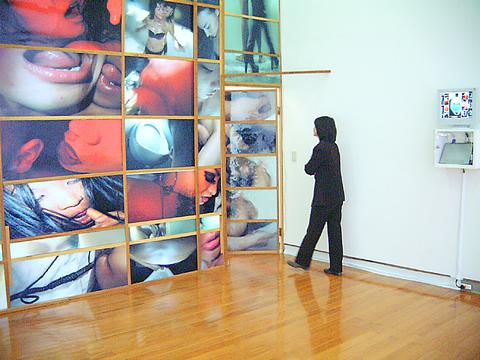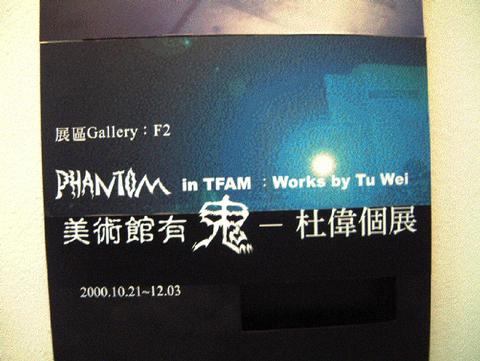Taiwanese film-maker and multimedia artist Shu-lea Cheang stirred up a bit of controversy last September at the Taipei Biennial (Taipei Fine Arts Museum) with a live audition for her upcoming sci-fi porn film Fluid. Yet Cheang's casting call was more of a media spectacle, for the local Chinese press at least, than anything particularly scandalous.
Bondage and art for the Taipei Biennial, Fluid consists of separate experimental phases: mainstream advertising, casting, filming and museum display. The digital prints from the live casting session were recently installed at TFAM where they will remain on view to the end of the Taipei Biennial, Jan. 7.

PHOTO: TFAM
After weeks of advertising in the local Taiwan press for aspiring porn stars, Cheang, on the night of the Biennial opening, filmed screen tests and shot photographs of the actors who performed nude or in bondage gear acting in front of a row of brightly lit urinals and a highly curious crowd of spectators. Even though some actors were a bit camera-shy, the casting set maintained the cool aura of a professional film shoot rather than a Saturnalian feast.

PHOTO:TFAM
For this latest installment of Fluid, a discreet closet-like space on the second floor of the museum has been set aside. One wall contains three urinals, again brightly lit, each containing a white cream-filled condom. The partition wall is coated with 70 glossy digital prints from the casting session framed with thin lattice strips. Some photos have a neon green tint reminiscent of a Nan Goldin photograph. Extreme close-ups expose wet lips and tongues, glittery eye shadow, glistening sweat, hair follicles and skin pores. Cheang's stylized bondage images consist of two pairs of hands loosely tied together and a bullwhip lying on the floor. Besides these erotic digital prints on display, a flat screen monitor displays Fluid's Web site with its moving images: http://www.wmw.com.tw/fluid/. After the success of her seductive Japanese porn film i.k.u, Cheang was keen to cast Fluid in Taiwan. It will be shot in Denmark next year with an international cast. The film will explore the state's role in relation to the body, especially in light of the AIDS crisis. Her wide interests have also led Cheang to examine the hot-button issues of pornography in the museum setting while continuing to place avant-garde art films in the adult triple-X world. Cheang continues to challenge her audience with the question: when is something pornographic and when is it art?
Ghost stories

PHOTO: NFAM
If you had the good fortune to go to TFAM last week, you may have seen a ghost wandering around in the basement. As legend goes, phantom-like creatures have been infesting the museum and making artworks disappear and causing a mysterious fire. Conceptual artist Tu Wei (杜偉) wanted to create an exhibition taking this ethereal figure as his starting point. His one-person show consisted of a sign posted adjacent to a locked gallery.
The sign showed that "you are here" and that the ghost is there. Besides warning visitors not to smoke, drink, eat or spread gossip, it also warned ghosts that they are unwelcome. According to Chinese beliefs, ghosts like to inhabit the corners of a room.
Tu Wei's installation was located in the most remote corner gallery in the museum's basement. Architecturally, the space has posed problems to artists trying to figure out how best to fill the cavernous gallery.
In Tu's show, the viewer, frustrated that the display area's door is locked, peers into the slight open crack of the doorway. Slowly emerging out of the distant dark shadows is a faint bluish hooded figure walking slowly towards the viewer which then suddenly vanishes.
For a work of art, Tu Wei, like Duchamp, only allows one viewer at a time to peer through the doorway. By not allowing entry into the room, Tu Wei succeeds in filling the space and your imagination with the spirit of a ghost.
Although this show is now over, the arts world gossip that inspired it -- a ghost in the gallery who seems to target some of the more challenging and physically explicit works displayed in the gallery -- may still be wondering about. Tu's work provides a slight element of humor to a mystery that remains unsolved.
Public Art
Another exhibition which uses location as part of its message is the photo installation sponsored by National Geographic is currently on view at the Chungshiao-Fushing and Hsimending MRT stations. Even though it is part of the promotion for the Chinese version of NG, the installation blends commercial display, architectural design and visual aesthetics to create a public art display. The designer, architect Chi Ti-Nan (季鐵男) and his workshop, sought to utilize the urban space by fragmenting the images -- here, images of exotic peoples from around the world -- and installing them on panels that coordinate with the stations' architecture. Chi also observes how the MRT stations' large passageways are ideal arenas for public art and another effective forum to enhance Taipei's visibility and international standing.
National Geographic is famed for its distinct photo style and by displaying these images larger than life in Taipei's public spaces, brings exposure to world cultures directly to the local populace.

May 26 to June 1 When the Qing Dynasty first took control over many parts of Taiwan in 1684, it roughly continued the Kingdom of Tungning’s administrative borders (see below), setting up one prefecture and three counties. The actual area of control covered today’s Chiayi, Tainan and Kaohsiung. The administrative center was in Taiwan Prefecture, in today’s Tainan. But as Han settlement expanded and due to rebellions and other international incidents, the administrative units became more complex. By the time Taiwan became a province of the Qing in 1887, there were three prefectures, eleven counties, three subprefectures and one directly-administered prefecture, with

It’s an enormous dome of colorful glass, something between the Sistine Chapel and a Marc Chagall fresco. And yet, it’s just a subway station. Formosa Boulevard is the heart of Kaohsiung’s mass transit system. In metro terms, it’s modest: the only transfer station in a network with just two lines. But it’s a landmark nonetheless: a civic space that serves as much more than a point of transit. On a hot Sunday, the corridors and vast halls are filled with a market selling everything from second-hand clothes to toys and house decorations. It’s just one of the many events the station hosts,

Among Thailand’s Chinese Nationalist Party (KMT) villages, a certain rivalry exists between Arunothai, the largest of these villages, and Mae Salong, which is currently the most prosperous. Historically, the rivalry stems from a split in KMT military factions in the early 1960s, which divided command and opium territories after Chiang Kai-shek (蔣介石) cut off open support in 1961 due to international pressure (see part two, “The KMT opium lords of the Golden Triangle,” on May 20). But today this rivalry manifests as a different kind of split, with Arunothai leading a pro-China faction and Mae Salong staunchly aligned to Taiwan.

Two moves show Taichung Mayor Lu Shiow-yen (盧秀燕) is gunning for Chinese Nationalist Party (KMT) party chair and the 2028 presidential election. Technically, these are not yet “officially” official, but by the rules of Taiwan politics, she is now on the dance floor. Earlier this month Lu confirmed in an interview in Japan’s Nikkei that she was considering running for KMT chair. This is not new news, but according to reports from her camp she previously was still considering the case for and against running. By choosing a respected, international news outlet, she declared it to the world. While the outside world